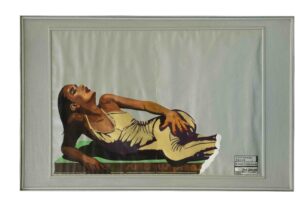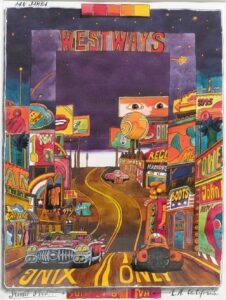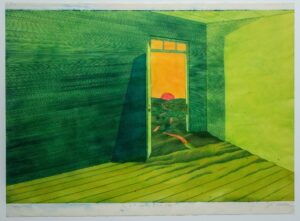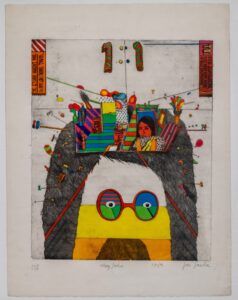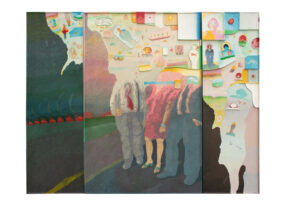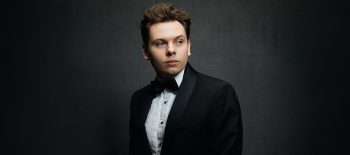“Dreams & Memories: Jan Sawka, Coast to Coast: An ONLINE SYMPOSIUM celebrating two exhibitions of work by Jan Sawka”
Saturday, May 2, 2020 @ 10 a.m. PST / 1 p.m. EST / 7 p.m. CEST
Panelists: Hanna Sawka (Jan Sawka’s widow), exhibition curators, Hanna Maria Sawka, MFA (Jan Sawka’s daughter) and Dr. Frank Boyer, as well as Ksenia Nouril, PhD., Dr. Peter Schwenger, Dr. Tom Wolf, Beth Wilson, M. Phil, Peter Frank, M.A., and Dr. Sławomir Magala
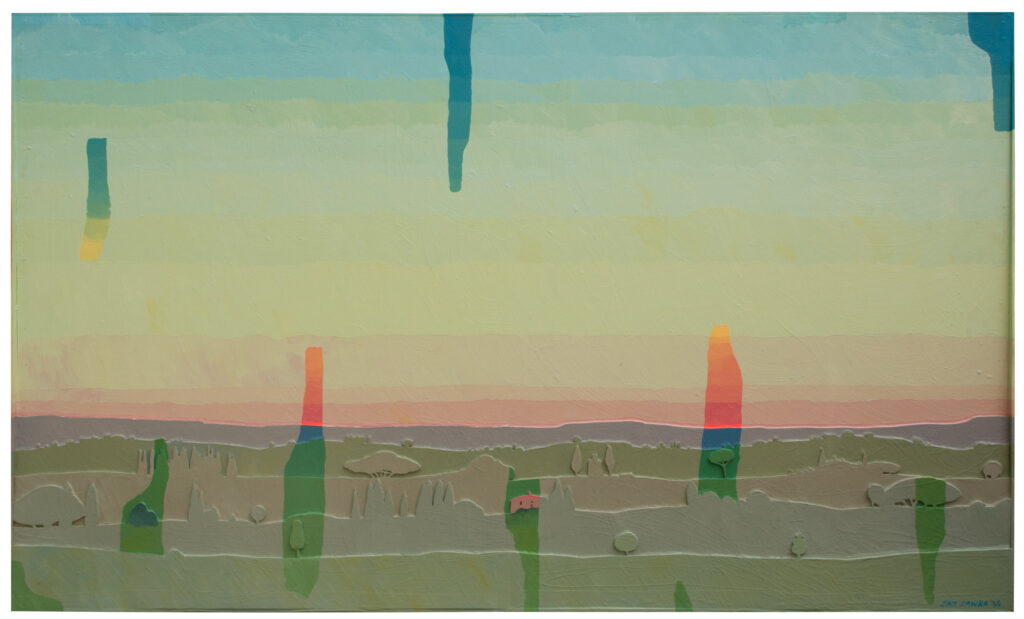
In the time of COVID-19, when our world is practicing social distancing, itself a form of displacement, the work of Jan Sawka is especially prescient and moving. Sawka’s works dealing with the longing for freedom, coupled with the deep empathy and sense of loss that only exile can bring, express an expansive sense of the beauty that hope, art and nature make available to human beings.
Separated by the whole of the country, two university art museums currently exhibiting the work of the late artist have joined together to present a symposium on his profoundly touching and, ultimately, humane work. In early February The Robert and Frances Fullerton Museum of Art (RAFFMA) at Cal State San Bernardino opened an exhibition featuring works dealing with his dream of the West, tempered by its problematic promises, titled “Golden West? Jan Sawka’s California Dream”, which is currently on view online. Almost simultaneously, the Samuel Dorsky Museum at SUNY New Paltz opened a thematic show titled, “Jan Sawka: The Place of Memory (The Memory of Place)” which is on view about memory and the places through which a human life passes. The exhibitions opened to critical and public enthusiasm, and full programs of events were planned for each institution throughout the run. Unfortunately, due to the pandemic both museums were closed to visitors in mid-March.
The staff of both museums, together with the exhibition curators, have partnered to cr
eate an online symposium, which will take place on May 2nd at 10 a.m. PST / 1 p.m. EST / 7 p.m. CEST, also announced by Hyperallergic.
Viewers from around the world will be able to join in as symposium speakers consider Jan Sawka’s life and achievement – and the connection of his career and art with California and New York – from several points of view, including the biographical, the historical, the technical, and the personal – yielding a composite portrait of this protean and visionary artist. After each presentation, viewers will be able to engage with any or all of the speakers over live Q&A chats.
Presenters from The Dorsky are Dr. Ksenia Nouril the Jensen Bryan Curator at The Print Center, Philadelphia, Dr. Peter Schwenger cultural critic and Resident Fellow at the Centre for the Study of Theory and Criticism at the University of Western Ontario, Canada, Dr. Tom Wolf Professor of Art History at Bard College, and Beth Wilson, M.Phil art critic and Art History Lecturer at SUNY New Paltz.
Presenters from RAFFMA are Peter Frank, M.A., art critic and a curator, Hanna Sawka (Jan Sawka’s widow), Dr. Sławomir Magala, and the exhibition co-curators Hanna Maria Sawka, MFA and Dr. Frank Boyer.
- © California Dream #1, Sunday’s Pleasure,” 1977, 48 x 75″, Acrylic on Masonite. Copyright Jan Sawka Estate. Photo by Camille Murphy
- © Sunset Boulevard (Westways Cover Art), 1978. Watercolor pencils and watercolors on paper. 17 x 11 in. Photo courtesy of the Automobile Club of Southern California Archive
- Jan Sawka, Swimming Pool, 1980. Courtesy of Jan Sawka Estate
- © Summertime , 1980. Hand-colored drypoint print, 19 x 25 in. Photo courtesy RAFFMA
- © The Story of Me and My Laughing Twin, 1979. Hand-colored aquaforte print, 25 x 19 in. Photo courtesy of RAFFMA
- ©Partial Recollection by Jan Sawka, 1997. 67 x 99”. Acrylic on Masonite. Courtesy of Jan Sawka Estate
Jan Sawka (1946-2012) was a visual artist, painter, printmaker, graphic artist, set designer, and architect. Already known internationally as a member of the Polish School of the Poster, he was exiled from Poland in 1976 and settled in New York City with his family in 1977, where he illustrated commentary for the Op-Ed page of the New York Times and designed graphics and sets for Off-Broadway theaters, as well as launching a successful gallery career as a painter. In 1989, he designed a monumental art-installation for the Grateful Dead’s 25th Anniversary tour. He won major awards including the “Oscar de la Peinture” and “Special Prize of the President of France” at the International Festival of Painting in Cagnes-sur-Mer in 1975, the Japanese Cultural Agency Award (1994), a Gold Medal in Multimedia at the 2003 Florence Biennial of Contemporary Art, and the “Excellence in Architecture Award” from the American Institute of Architects (2010). Learn more at jansawka.com.
Symposium is organized by the Robert and Frances Fullerton Museum of Art at California State University San Bernardino, Samuel Dorsky Museum of Art (SDMA) in SUNY New Paltz, and Hanna Maria Sawka MFA, in partnership with the Polish Cultural Institute New York, and supported by The Kościuszko Foundation, the SUNY New Paltz Foundation Inc., and the Consulate General of the Republic of Poland in Los Angeles.
About RAFFMA
The Robert and Frances Fullerton Museum of Art, nationally accredited by the American Alliance of Museums, houses a collection that includes Egyptian antiquities, ceramics and contemporary art, and hosts ca. 10-12 temporary exhibitions a year. Located at Cal State San Bernardino, RAFFMA presents the largest public display of ancient Egyptian art in Southern California. The exhibition, Journey to the Beyond: Ancient Egyptian in the Pursuit of Eternity, will be on display through April 2021. Visit the RAFFMA website for more information. www.csusb.edu/raffma
About The Dorsky Museum
Through its collections, exhibitions and public programs, the Samuel Dorsky Museum of Art supports and enriches the academic programs at the College and serves as a center for Hudson Valley arts and culture. With more than 9,000 square feet of exhibition space distributed over six galleries, The Dorsky Museum is one of the largest museums in the SUNY system. Since its official dedication in 2001, The Dorsky has presented more than 100 exhibitions, including commissions, collection-based projects, and in-depth studies of contemporary artists including Robert Morris, Alice Neel, Judy Pfaff, Carolee Schneemann and Ushio Shinohara.
The Kosciuszko Foundation
The Kosciuszko Foundation is dedicated to promote educational and cultural exchanges between the United States and Poland and to increase American understanding of Polish culture and history.
Founded in 1925, on the eve of the 150th anniversary of Thaddeus Kosciuszko’s enlistment in the American revolutionary cause, the Foundation is a national not-for-profit, nonpartisan, and nonsectarian organization.
The Foundation’s work reaches audiences throughout the United States, through its headquarters in New York City and its regional Chapters in Chicago, Denver (Rocky Mountain), Houston (Texas), Philadelphia, Pittsburgh, Springfield (New England), Buffalo (Western New York State), Ohio (Cleveland) as well as through its National Advisory Council.
The Kosciuszko Foundation is a membership organization, which is supported by contributions from foundations, corporations, and individuals who share the Foundation’s mission of fostering the relations and understanding between the United States and Poland.
It awards up to $1 million annually in fellowships and grants to graduate students, scholars, scientists, professionals, and artists, and promotes Polish culture in America. The Foundation has awarded scholarships and provided a forum to Poles who have changed history.
www.thekf.org

